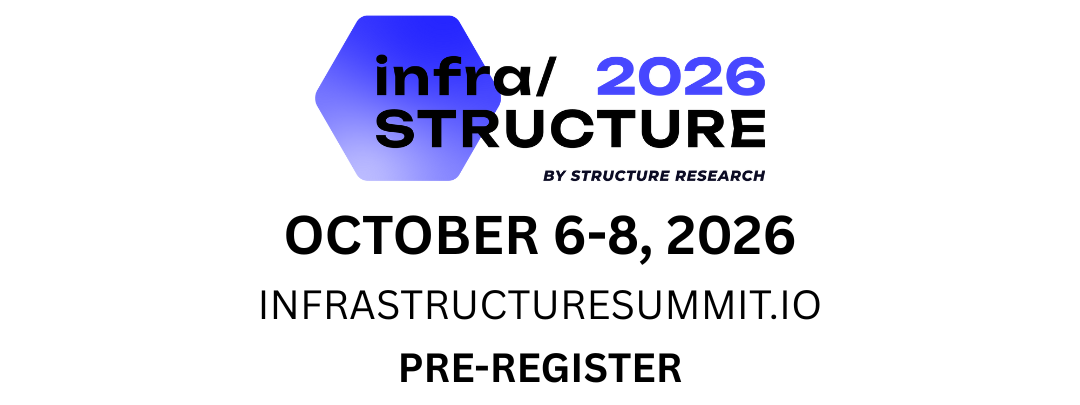WSS: Growth, global expansions and energy demand drive investment in infrastructure; but will it encourage speculation and unequipped new entries?
It is peak season for us here at Structure Research as we host our annual infra / STRUCTURE summit in Las Vegas. This is the fifth annual edition of the summit we started back in 2018 in Toronto, where we are based. After four editions of the summit, and two cancels due to the global pandemic, we are now moving to Las Vegas this year with the goal of taking things to the next level. Las Vegas provides more space and venues for networking, meetings and of course, fun. On top of that, you don’t have to deal with the traffic nightmare that is burying the city of Toronto. We hope you are registered to attend the summit and if you are reading this now, there may be a few last minute tickets available. The summit is an excellent opportunity to take advantage of high-quality networking, get caught up on where the sector is headed, hear perspectives from though leaders and see fresh market data from our research team. There are plenty of data centre and digital infrastructure conferences these days, but none have developed a reputation for having independent, high-quality content that is un-commercialized. Except for infra / STRUCTURE.
We have always taken a global view to our research and the agenda at our summit reflects that. We will be presenting insights and data on markets in Europe, LatAm and APAC. And in the past week, we saw expansion activity in a number of these places. Data4 is set to build in Athens, Greece, STT GDC broke ground on an expansion project in Jakarta, Indonesia, CyrusOne’s JV with KEPCO in Japan is underway and FLOW Digital Infrastructure pushed forward in the Philippines.
There was more development and expansion activity in the US. Flexential recently shared some data points on its expansion capacity, highlighting developments in Atlanta, Hillsboro and Denver. Meanwhile, DataBank revealed plans to develop a nearly 500MW data centre in Dallas. The size of the build, needless to say, speaks clearly to the volume of requirements in the demand pipeline.
Hyperscale and AI, of course, is the primary driver of sector demand. Oracle is seeing more imbalance between supply and demand and confirmed this in its recent quarterly earnings report. Top-line revenue growth for cloud infrastructure is showing signs of more acceleration, but perhaps more importantly, Oracle is pushing hard to expand its capacity and build out data centre infrastructure, with facilities in the hundreds of megawatts. It is a surefire sign that it is seeing healthy demand signals. Oracle also confirmed that it is exploring nuclear energy sources for a gigawatt-level site it is building. Oracle Cloud continues to push the envelope and it just established a new interoperability agreement with AWS. This is not its first rodeo. Oracle Cloud already has an interoperability relationship with Microsoft in place and recently did the same with Google. The market often talks about the ‘big three’ hyperscalers when it comes to public cloud. But Oracle Cloud has clearly moved into that conversation and from a data centre perspective, it makes more sense now to talk about a ‘big four’.
The energy sector continues to see strong demand from data centres and they are disclosing very interesting data points. Duke Energy, which serves the Carolinas region, shared some data points that project data centres being a significant component of its business by the end of the decade. Meanwhile, Xcel Energy is making headway into the Mountain and Midwest regions, with demand coming from both data centre operators and hyperscalers. Xcel confirmed that the demand profile out to 2030 is in the gigawatts. Energy constraints are about both capacity and sustainability, and in places like Ireland, both factors have made it difficult to get power in the Dublin area. But Echelon Data Centres recently confirmed getting a grid connection in Arklow, which is about 75km south of Dublin.
The strategic landscape is picking up the pace and the last half of the year has always been a busy period. There was another transaction of note in the past week as 1547 Critical Systems Realty acquired another connectivity-oriented data centre asset in a secondary market. This carrier hotel is in South Bend, Indiana and sits at the crossroads of connectivity paths connecting major markets like Chicago with the eastern seaboard of the US. The acquisition looks to be a good one as there is significant hyperscale infrastructure being developed in the US Midwest in places like Ohio and Indiana, and the edge infrastructure and traffic flows are going to require a significant upgrade in overall capacity. Still on the strategic side, Serverfarm acquired two enterprise data centres in Houston, Texas that it will take over and turn into multi-tenant data centre colocation facilities. Serverfarm has deployed this strategy before and looks to already have pre-leasing and/or sale-leaseback commitments secured.
Amid all the demand signals that are hard to miss, there is some concern emerging around speculative builds and one of our analyst content contributors, Daniel Golding of Appleby Strategy Group, poses the provocative question: are we entering the age of fake data centres? Dan’s point is that the asks for power continue to astronomical, but given the relative shortage of legitimate hyperscale data centre operating expertise, and the extremely high costs of building data centres, and challenges around permitting and regulation, is some of this demand fake? Or at the very least, is it speculative or representative of groups and investors that may not be able to realistically serve hyperscale clients and seriously build and operate a data centre business? It is a fair and important question to ask. And this kind of activity, and the questions that come with it, seem to emerge at the outset of significant development and expansion waves. There was talk of speculation, and ‘questionable’ operators, just before the hyperscale cloud wave took off. And if we look back further, there was speculative activity in the wake of the dotcom bubble and collapse. The one thing that always seems to work out: the cream usually rises to the top. Is history repeating itself? Are we going back to the future? We try to answer those questions in Las Vegas next week. Join us and be a part of that conversation.
or



